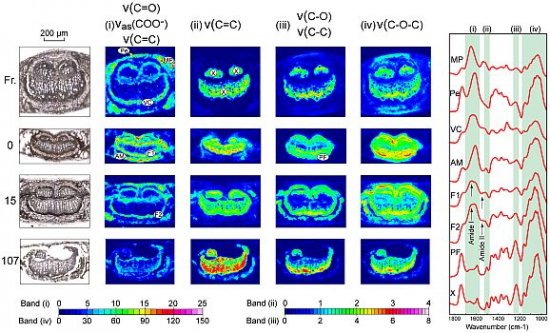In wetland areas, aquatic fungi play a critical role in decomposing gum leaves into biodegradable forms, and non-biodegradable forms that keep carbon locked up in long-term storage.
Researchers from La Trobe University’s Wodonga and Bundoora campuses, the Murray-Darling Freshwater Research Centre and the Australian Synchrotron used synchrotron infrared microspectroscopy to examine how eucalypt leaves degrade in wetland areas, which are a major environmental carbon sink. They studied lignified leaf vein material (xylem) from River Redgum trees (E. camaldulensis) endemic to the lowland rivers of south-eastern Australia.
Wetlands occupy around one-twentieth of the world’s land surface area but contain one-third of the organic matter stored in the world’s soils. Leaf litter is an important source of carbon, contributing to the aquatic food web as well as the formation of stored organic carbon.
The team’s investigation of biomolecular changes in leaf tissue during fungal decomposition is the first spatially-related study of how fungi separate lignified material into biodegradable and non-biodegradable forms. Fungi are one of the few organisms capable of breaking down woody (lignified) tissue.
Infrared microspectroscopy allowed the researchers to directly examine changes in leaf lignin composition in close proximity to fungal tissue, providing far more detailed information than would be possible with a conventional laboratory infrared source.
Janice L. Kerr et al., PLOS ONE, 8, e60857, (2013)

Above: Figure 2 from the PLOS paper.
 Figure 2: Photomicrographs and transmission IR images of the mid-vein of: fresh leaf from living tree (Fr.), terrestrially-aged leaf collected from floodplain litter (0) and terrestrially-aged leaves subsequently submerged in a floodplain wetland for 15 (15) and 107 (107) days. MP = mesophyll protein, Pe = pectin, AM = aromatic material, F = fungal-containing material. doi:10.1371/journal.pone.0060857.g002
Figure 2: Photomicrographs and transmission IR images of the mid-vein of: fresh leaf from living tree (Fr.), terrestrially-aged leaf collected from floodplain litter (0) and terrestrially-aged leaves subsequently submerged in a floodplain wetland for 15 (15) and 107 (107) days. MP = mesophyll protein, Pe = pectin, AM = aromatic material, F = fungal-containing material. doi:10.1371/journal.pone.0060857.g002
Right: Figure 3 from the PLOS paper.
Figure 3 Photomicrographs and synchrotron transmission IR images of: fresh leaf from living tree (Fr.), terrestrially-aged leaf collected from floodplain litter (0) and terrestrially-aged leaf subsequently submerged in a floodplain wetland for 15 (15) days. doi:10.1371/journal.pone.0060857.g003
